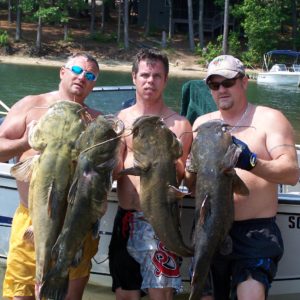Bare-hand catfishing is approaching its peak in lakes across the Carolinas
By now, almost everyone has seen reality shows where a bunch of rough-looking folks feel around on a river or lake bottom trying to catch catfish by hand. Called grabbing, gravelling or noodling, bare-hand catfishing has become a national past time in other areas, but few realize it’s also a popular sport here in the Carolinas, and it’s about to reach its seasonal peak as fish move to spawn.
“It only lasts here about 3 to 4 weeks,” said Michael Brooks of Ware Shoals, who has been grabbing for catfish for almost 20 years. “You can grab blue catfish, but most of the time it’s flatheads, so any lake that has a population of flatheads will be good from mid to late May through June.”
Though river fishing is popular, Brooks prefers to do his grabbing in major impoundments. He said Lake Hartwell, Lake Russell, Clarks Hill Lake and Lake Murray all have good flathead populations, and he rarely goes anywhere else.
“Flatheads are the most protective, and they like to find holes to nest in,” he said. “Before the female lays her eggs, it’s not hard to run one out of a hole, but after the young are hatched, they will guard that hole and stay put.”
Some folks build nests for the fish
Because of the growing popularity, Brooks said the biggest challenge is finding natural holes in shallow water where flatheads will nest. A few years ago, he discovered one of the best ways to have plenty of grabbing holes is to build his own, but that requires some extra work.
“I have an uncle in the grading business, and he always has a bunch of concrete culvert pipes lying around,” he said. “A broken pipe about 4 to 5 feet long set against the bank in 8 to 10 feet of water is ideal. I have some that have been in the water almost 10 years now. It seems like the older the pipe gets, the better they like them.”
Catfish grabbing is as much luck as skill. Brooks dives down and tries to block the open end of the pipe with his body while reaching in with one hand. The catfish either fights or flees. If Brooks is lucky, the catfish will latch on to his hand or wrist, and he can then work for a better grip and then push off to the surface. If the catfish flees or he only grabs a fin or tail, the fish usually gets away.
Brooks said he releases most of the fish he catches but occasionally will keep one or two to eat. He said the thrill for him is in the catching, not the eating.




